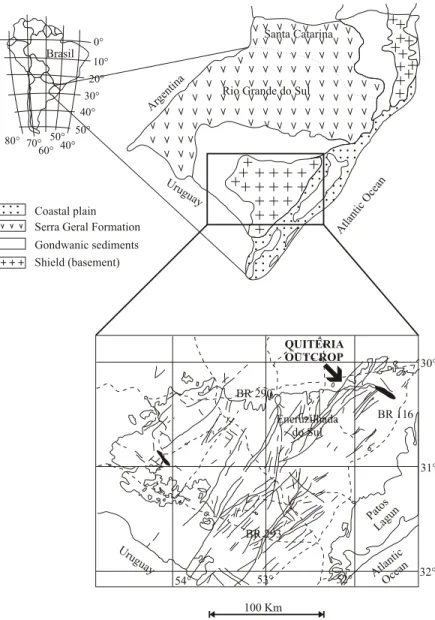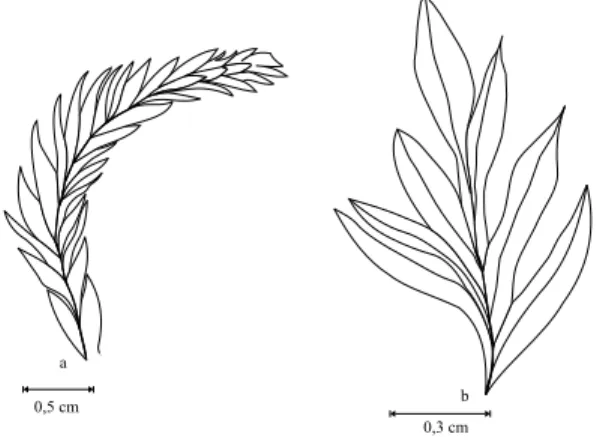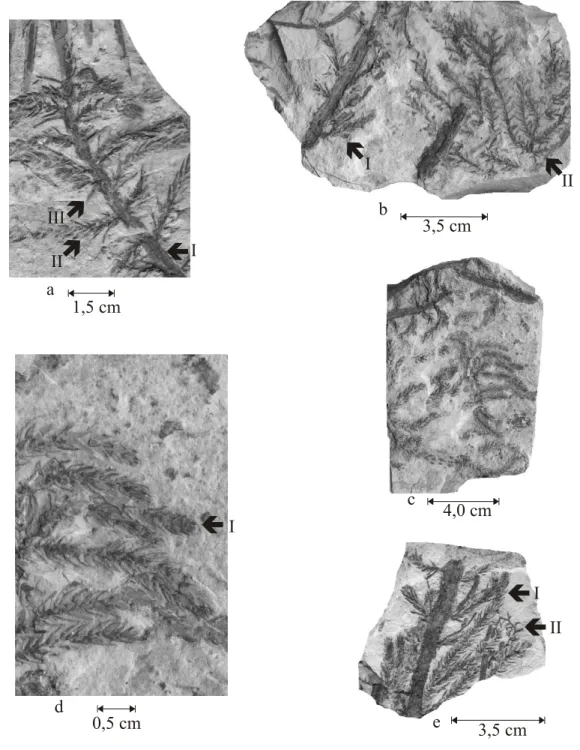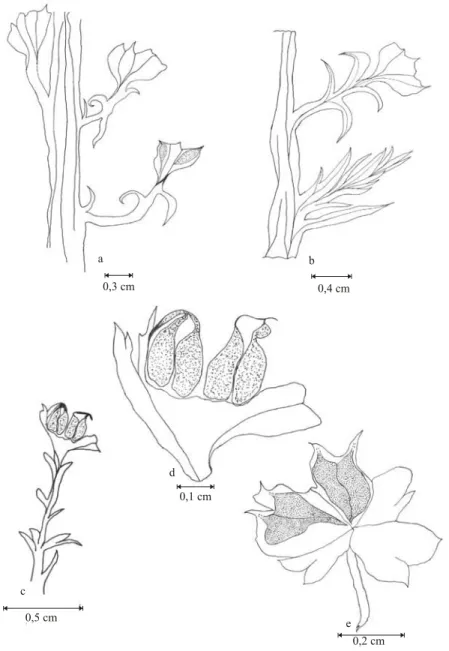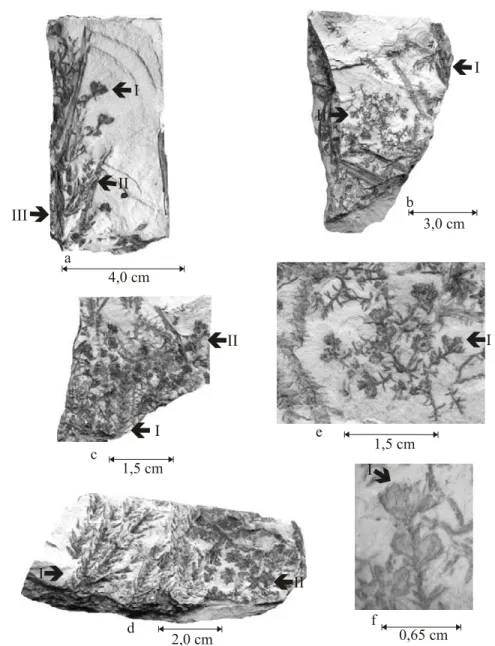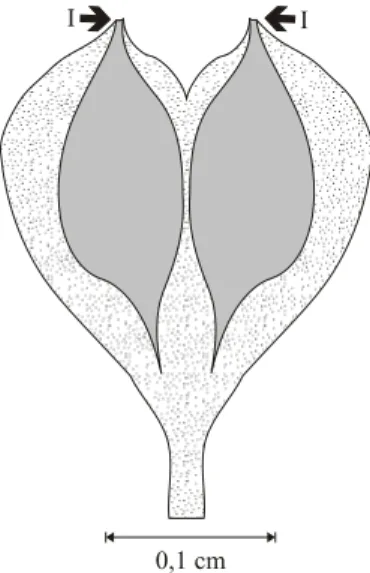Coricladus quiteriensis
gen. et sp. nov., a new conifer
in Southern-Brazil Gondwana (Lower Permian, Paraná Basin)
ANDRÉ JASPER1, FRESIA RICARDI-BRANCO2 and MARGOT GUERRA-SOMMER3
1Setor de Botânica e Paleobotânica do Museu de Ciências Naturais do Centro Universitário da UNIVATES (SBP/MCN/UNIVATES)
Rua Avelino Tallini, 171 – 95900-000 Lajeado, RS, Brasil 2Instituto de Geociências, Universidade Estadual de Campinas (UNICAMP)
Caixa Postal 6152 – 13083-970 Campinas, SP, Brasil
3Instituto de Geociências, Universidade Federal do Rio Grande do Sul (IG/UFRGS) Avenida Bento Gonçalves, 9.500 – 91051-970 Porto Alegre, RS, Brasil Manuscript received on March 3, 2004; accepted for publication on July 21, 2004;
presented byAlcides N. Sial
ABSTRACT
A newtaxonof conifers (Coricladus quiteriensis) is described based on megafloristic remains from the roof-shale level at the Quitéria Outcrop (Rio Bonito Formation – Lower Permian – Southern Paraná Basin – Rio Grande do Sul – Brazil). This megafloristic community is included in theBotrychiopsisZone –Botrychiopsis validaSub-Zone (Kungurian/Roadian). The assemblage, preserved as impressions, do not present remains of epidermic characters, and is composed mainly of isolated vegetative branches with spirally disposed acicular leaves, presenting a conspicuous central vein and also isolated fertile branches with sparse and irregular leaves and terminal cones. Leafless principal branches, organically connected with sterile and fertile branches, are rare. Reproductive feminine scales, disposed in a plane, are organized in lax terminal cones on branches, composed by 4 (four) distal ovuliferous scales, and 8 (eight) elliptical-elongated anatropous seeds. Paleoecological data pointed out to a mesophylous to higrophylous habitat in swampy environments.
Key words:Coricladus quiteriensis, paleobotany, taxonomy, coniferopsida, Gondwana, Lower Permian.
INTRODUCTION
In Paleozoic Gondwana, the replacement of the Late Carboniferous flora by the glossopterid pre-vailing flora has been connected to a warming phase at the end of an icehouse stage (Gastaldo et al. 1996, Wnuk 1996, Anderson et al. 1999).
Conifers are common elements in the Glossopteris Flora, in taphofloras of wet lowland biomes of Early Permian, and sedimentary
se-Correspondence to: André Jasper E-mail: ajasper@univates.br
quences included in the Carboniferous/Early Tri-assic Megasequence of the Paraná Basin by Milani et al. (1998). This basal transgressive sedi-mentary section includes the lithostratigraphic units Itararé and Guatá Groups, comprising taphofloras preserved in lowland glaciocontinental sediments, and the Rio Bonito Formation, where are located most of the southern Brazil coal-bearing strata out-cropping in isolated coal fields.
low-land floras across different areas and indi-cate vegetational heterogeneity within any coal-field. The presence of well preserved fragments of conifers, some of them corresponding to reproduc-tive structures, in roof-shales, indicates to Guerra-Sommer et al. (2001) that group was an impor-tant element in lowland floras at the time of deposi-tion of coal seams. In a reconstrucdeposi-tion of a clastic swamp landscape unit by the analyses of a roof-shale flora at the Quitéria outcrop (UTM 0387516E and 6643183N – Fig. 1) were identified three plant com-munities from a paleoenvironment associated to a lagoon/barrier system defined by Jasper and Guerra-Sommer (1999) based in previous regional strati-graphic studies (Della Fávera et al. 1994, Lopes and Lavina 1995, Holz 1997). The Arborescent Lyco-phyte Community was dominant; the Glossopteris Community, including also Cordaites, the under-story vegetation (Rhodeopteridium, Botrychiopsis valida, herbaceous lycophytes), and the Conifer Community were common, but less significant, in that landscape unit.
This paper aims at describing and identifying the conifer material proceeding from the Quitéria roof-shale, to contribute to the understanding of the evolution of this group during the Upper Paleozoic, in Gondwanaland.
Taking into account the reproductive structure organized in lax cones on branches that are orga-nized in lax cones, the forms here analyzed are con-sidered as coniferssensu lato; in the present work are accepted the definitions of Biwas and Johry (1997) which consider as conifers the groups related to phylogeny of coniferophytes.
MATERIALS AND METHODS
Conifer fragments are concentrated and numer-ically predominant in lenticular facies within the roof-shale in a four meter transect of the outcropping area, at the same level asBrasilodendronstumps and Botrychiopsis validafronds. This exposure provides a rare look at the short-term spatial heterogeneity in contemporaneous deposits. For stratigraphic details
see Piccoli et al. (1991), Jasper and Guerra-Sommer (1998, 1999) and Jasper et al. (2003).
The plant assemblage here studied is included, by Jasper et al. (2003), in theBotrychiopsisZone/ Botrychiopsis validaSub-zone (Artinskian/Kungu-rian Interval). This age are confirmed by Cazzulo-Klepzig et al. (2002) with zircon radiometric dating of volcanic rocks interbedded in coal seams of Rio Bonito Formation in Southernmost Paraná Basin. Cazzulo-Klepzig et al. (2002) yielded an age of 267,1±3,4 My which corresponds to the Kungu-rian/Roadian Interval. Reproductive branches and cones are preserved as impressions, but the preserva-tion is exceppreserva-tional and fine structural tridimensional details are available. The assemblage is composed by: a) dispersed, non-orientated vegetative and re-productive branches, branching up to third order, with spirally disposed acicular-lanceolate leaves; b) fertile isolated reproductive branches, with sparse, irregular acicular-lanceolate leaves and ter-minal cones; c) leafless principal branches in organic connection with fertile and vegetative reproductive branches branched up to third order, maintaining the same morphological parameters as the isolated spec-imens.
The material was analyzed using standard pa-leobotanical techniques of light microscope. Mac-eration techniques in leaves and cones did not yield epidermis and palynological material. The samples are stored in the Botany and Paleobotany Sector of the UNIVATES Natural Science Museum (PbU).
SYSTEMATIC DESCRIPTION
The systematic disposition of the plant fossils, adopted in the present paper, is the one used by Stewart and Rothwell (1993), Taylor and Taylor (1993), Biwas and Johry (1997) and Judd et al. (1999), who used cladistic methods to include the fossil forms in the group defined as modern plants.
Realm Plantae
80° 60°
50° 50° 40°
40° 30°
20° 10° 0°
70°
Rio Grande do Sul Santa Catarina
Coastal plain Serra Geral Formation Gondwanic sediments Shield (basement)
Atlanti Ocean c g
in
Ar ent
a
Uruguay
54° 53° 52° 32°
31° 30°
Patos Lagun
Al n i t at c
Oce an BR 290
BR 116
BR 293
g Uru
uay
Encruzilhada do Sul
100 Km Brasil
QUITÉRIA OUTCROP
Fig. 1 – Localization of the Quitéria outcrop (adapted from Jasper et al. 2003, Fig. 2).
Coricladusgen. nov.
Generic Diagnosis
Compounded branches, leafless principal bran-ches, bearing homomorphic, linear, sessil, straight basis, decurrent bracts, tapering gradually towards the apex. First order branches covered with heli-cally disposed and overlapping leaves. Second and third order branches with the same leaf disposition observed in first order branches; at the apical por-tion there are globular densificapor-tions, formed by the
4 (four) scales and 8 (eight) elliptically elongated seeds.
– Type species:Coricladus quiteriensissp. nov. – Derivation of name: Genus from Guarani lan-guage, cori, pine tree, and from Greek cladus, branch. Specific epithet from the Quitéria outcrop, local of occurrence from this species.
– Holotype: PbU 074 (stored in the Botany and Pa-leobotany Sector of the UNIVATES Natural Science Museum).
– Paratypes: PbU 003, 005, 012, 018, 020, 022, 023, 025, 029, 030, 032, 034, 035, 037, 038, 039, 046, 047, 055, 056, 057, 060, 071, 072, 073, 075, 076, 078, 082, 091, 093, 094, 121, 133, 136, 162, 164, 165, 166, 169, 174, 175, 176, 183, 186, 187, 189, 191, 192, 197, 198, 200, 218, 217, 219, 220, 221, 222, 223, 225, 226, 228, 229, 237, 238, 239, 241, 242, 245, 248, 253, 260, 266, 267, 268, 271, 273, 298, 366, 367, 390, 392, 417, 418, 419 and 426.
– Type formation: Rio Bonito Formation, Permian (Sakmarian/Roadian Interval), Paraná Basin.
– Proceeds from: Quitéria Outcrop, Encruzilhada do Sul, RS.
Coricladus quiteriensissp. nov. (Fig. 3 and 5)
Specific Diagnosis
Compounded sterile branches, with three branch-ing orders. Leafless principal branches, bearing homomorphic, linear, sessil, straight basis, decur-rent bracts, becoming slightly pointed towards the apex, with a conspicuous central vein. First order branches with leaves disposed in overlapping spi-rals, with decurrent insertion. Second and third or-der branches have the same leaf coverage pattern as the first order branches; their apical portions present a globular densification, formed by the whole of the leaves. Leaves are single, with a conspicuous cen-tral vein, homomorphic, sessil, bifacial, acicular, slightly falciform, with straight basis, acute apex. From the leafless principal branches, come branches
with leaves of morphology identical to the one of the first, second and third order branches, although with scarce and alternate-opposite distribution. At the apical portion of these branches, the leaves gradually transform into bracteal scales, associated to ovulif-erous scales. Four ovulifovulif-erous scales, located at the final portion of the branch forming a cone. They present decurrent insertion, overlapping but clearly separated edges, with cuneiform basis, biphid apices and smooth edges. Each of the portions of the apices with torsion is elongated into a funicle, with anat-ropous seed. Cones with 1 (one) level of ovuliferous scales, 4 (four) in the scale verticile and 8 (eight) el-liptically elongated seeds, thickened at the central portion.
b a
0,3 cm 0,5 cm
Fig. 2 –Coricladus quiteriensissp. nov. vegetative branches: (a) apical portion of a branch, demonstrating the disposition of the leaves – PbU 191; (b) apical portion of a branch, demonstrat-ing the conspicuous central vein at the leaves – PbU 136.
Description
1,5 cm
3,5 cm
4,0 cm
0,5 cm
a
b
c
d
3,5 cm
e
I
I
I
II
II
II
I
III
of 45-60◦, covered with leaves disposed in overlap-ping spirals, with decurrent insertion at an angle 25-45◦, what provides some branches with a more dense coverage, but not so dense to others (Fig. 3b). From the first order branches come second and third order branches with 7.5-19.8 mm length and 2.4-4.8 mm width and the same leaf coverage pattern observed in first order branches (Fig. 3c), presenting, in their apical portion, globular densification of the leaves, which clearly characterize apical sprouts (Fig. 3d). First, second and third order branch leaves are sin-gle, homomorphic, sessil, bifacial, acicular, slightly falciform, with straight basis and acute apex, 1.8-5.5 mm long and 0.6-1.1 mm basis width, and with a conspicuous central vein.
From the leafless principal branches come re-productive branches with 5.3-19.7 mm length and 0.7-1.2 mm width, inserted in an angle of 60-70◦and presenting scarce leaves (Fig. 3e, Fig. 4a and b, and Fig. 5a), which are single, homomorphic, sessil, bi-facial, acicular, slightly falciform, with straight ba-sis, acute apex, alternate-opposite disposition, with decurrent insertion of 60-90◦ angles, 1.3-3.5 mm apart one from the other, 1.7-2.4 mm length and (0.5-0.9 mm) basis width as well as a conspicuous central vein.
At the apical portion of these branches, leaves are gradually transformed into bracteal scales, asso-ciated to ovuliferous scales (Fig. 4c and Fig. 5a,b,c and d). There are 4 (four) ovuliferous scales, lo-cated in the terminal portion of each branch, radially and circular-plane disposed around the axis, form-ing a cone (Fig. 4d and e, and Fig. 5e and f). These scales present decurrent insertion of 30-80◦angles, with overlapping but clearly separated edges, with laminar and obovate morphology, 2.5-5.1 mm long, 0.4-0.9 mm basis width and 1.3-2.5 mm wide at the central portion (Fig. 4e). The basis are cunei-form, apices are biphid, with sharpened terminal portions, with smooth edges. Each portion of the biphid apices presents a torsion towards its adax-ial portion in relation to the branch, elongating and forming a structure that can be related to funicle, where two seeds are adpressed in anatropous
posi-tion (Fig. 6). Each cone presents only 1 (one) level of ovuliferous scales totalizing 4 (four) scales and 8 (eight) elliptically elongated seeds, thickened at the central portion, 0.8-1.8 mm long and 0.6-1.0 mm wide at the central portion. On the surface of some samples, some signs of tegument are clearly visible.
DISCUSSION
The branching pattern (Fig. 7), characterized by: a) the irregular disposition of foliar reproductive branches on a leafless principal branch, forming an-gles over 60◦; b) the presence of leaves with a main vein, acicular-lanceolate, helically attached to the principal branches, forming angles between 60◦and 90◦, of first, second and third orders; c) the fe-male reproductive structures characterized by a maximum of four ovoliferous scales, located at the terminal portion of the fertile reproductive branch, showing radial-plane disposition forming a lax cone, are all features quite different from those of other conifers registered in other horizons of several lo-calities in Gondwana realm, at the Permian.
0,5 cm c
a b
0,3 cm 0,4 cm
0,1 cm
0,2 cm d
e
Fig. 4 –Coricladus quiteriensissp. nov. reproductive branches from Quitéria outcrop: (a) reproductive branches coming from the leafless principal branches, presenting scarce leaves – PbU 073; (b) reproductive and vegetative branches, coming from the same leafless principal branch – PbU 075; (c) detail from a reproductive branch with bracteal scales, associated to ovuliferous scales at the apical portion – PbU 222; (d) lateral detail from a cone with seeds – PbU 222; (e) detail from a cone with 4 (four) ovuliferous scales radially and circular-plane disposed around the axis, with the presence of 4 (four) elliptically elongated seeds (two/scale) – PbU 222.
The genus Paranocladus Florin (1940) is registered in Brazilian Sequences of Paraná Basin with the species: Paranocladus dusenii and
unpub-0,65 cm f
1,5 cm e
4,0 cm a
3,0 cm b
1,5 cm c
2,0 cm d
I
II
I
I
I
II
I
II
I
II
III
Fig. 5 – Coricladus quiteriensis sp. nov. reproductive branches from Quitéria outcrop: (a) reproductive (I) and vegetative (II) branches, coming from the same leafless principal branch (III) – PbU 073; (b) association of vegetative branches (I) and reproductive branches (II) with bracteal scales, associated to ovuliferous scales at the apical portion – PbU 222; (c) association of vegetative branches (I) and reproductive branches (II) with bracteal scales, associated to ovuliferous scales at the apical portion – PbU 190; (d) association of vegetative (I) and reproductive (II) branches – PbU 057; (e) detail from the reproductive (I) branches – PbU 222; (f) detail from the reproductive branches, with the presence of elliptically-elongated seeds in anatropous position (I) – PbU 222.
lished data). This form genus of leaf reproductive branches, bearing small leaves in a spirally dispo-sition, parallel veined adpressed to the axis,
0,1 cm I
Fig. 6 – Hypothetical reconstruction of the bract-scale complex ofCoricladus quiteriensissp. nov., with the seeds adpressed in anatropous position (I).
4,0 cm
Fig. 7 – Reconstruction of the branching system ofCoricladus quiteriensissp. nov.
Basin (Teresina Formation) presents heteromorphic foliage represented by elongated leaves, mid-veined, with rounded or biforked apices (Yoshida 1970). These characteristics, similar to Buriadia type, are quite diverse from those of the material
of the Quitéria outcrop. Isolated female organs are considered, by indirect association, as related to Krauselcladusreproductive branches. These cones are composed of series of bracts arranged in heli-cally sequences bearing symmetric axillary bracts with seeds, probably orthotropous, in bilateral dis-position. All features of both vegetative and repro-ductive organs are morphologically diverse from the material of Quitéria outcrop.
The genusBrasilocladusYoshida 1981, in Ber-nardes de Oliveira and Yoshida (1981) with strongly acicular leaves differs from the morphology of the leaves of the specimens described in this paper. This also happens with the representatives of the genus Paranocladus, which present scale-shaped leaves.
Sterile reproductive branches identified as Walkomiella sp. are registered in Upper Permian Sequences of northern Paraná Basin (Irati Forma-tion) by Ricardi-Branco et al. (1999). The genus Walkomiella, described by Florin (1940) with the type speciesWalkomiella australis described from Sidney Basin, Australia, and by Walkomiella transvaalensisLe Roux (1963) from Lower Permian of Karoo Basin, is represented by foliage reproduc-tive branches variously branched, with leaves ad-pressed, imbricate, spirally arranged, rhomboidal with acute apex, leathery. The female cones of Walkomiella australis, described by White (1981) from Australia are compact, composed of a complex of scales and seeds. InWalkomiella indica, Surange and Singh (1951) used a sample of coal coming from Barakar to describe the female cone, composed of seeds in connection to a central axis. Based on these characteristics, it is concluded that the organization of sterile and fertile parts ofWalkomiellais different from the material under analysis.
ra-dial branching, with small, lanceolate, single veined, helically disposed leaves, and the female cones com-posed of a central axis with bracts and orthotropous ovules which are disposed helically, and present-ing platyspermic seeds are dissimilar from the spec-imens here analyzed. Expressive number of dis-persed reproductive branches of second order previously attributed toParanocladus patagonicus Feruglio 1934, proceeding from the same level, where synonymized toFerugliocladus patagonicus given support to the establishment of the family Ferugliocladaceae.
Comparisons with the genera identified in other provinces of Gondwanaland at the Permian, discussed above, show significant morphological differences.
The sterile foliage ofPagiophyllumfrom Heer (1881) is mentioned by Anderson and Anderson (1985), as the speciesPagiophyllum vandijkiifrom Upper Permian of South Africa and is represented by reproductive shoots with spirally arranged leaves, contracting gradually from the broad basal cushion, randomly distributed, broader than thick, its length exceeding the width of its own basal cush-ion. Sterile foliage of thePagiophyllumtype found in organic connection with female cylindrical cones, terminally compact on short branches, composed of forked bracts and cone scales, expanded in lobes bearing inverted ovules, were elements that allowed the identification ofVoltziopsis(Potonié) Townrow (1967) referred to Lower Triassic of South Africa. Archangelsky (1996), agrees with Townrow (1967) placing this genus in the family Voltziaceae, which has Euramerican representatives. In the other hand, the specimens here studied, present a singular fe-male cone with only one level of ovuliferous scales, and do not form a cylindrical cone asPagiophyllum. The distinctive characteristics of the specimens here analyzed preclude their inclusion in a different conifer family and genus recognized so far. There-fore, it is proposed a new taxonomic unit identified as Coricladus genus with the type species Coricladus quiteriensis.
CONCLUSIONS
The characteristics presented by the material here studied, despite presenting some morphologic similarity in the vegetative portions with gondwanic forms already described, justified the creation of a newtaxon. It is not possible to establish affinities at the family level because the attempts to collect epidermis and pollen fragments were not success-ful, making it necessary to create a morphogenus. The available data, however, allow suggesting a general morphology reconstitution ofCloricadus quiteriensis.
Archangelsky and Cúneo (1987) suggested two probable phyletic lines for Urgatecladusand Ferugliocladus, based on the structure of the ovuliferous scales and ovules, from a common an-cestor, theWalchiaceae. However, the characteris-tic of the cones found inCoricladus, with 4 (four) ovuliferous scales distributed on a plain level and bearing anatropous ovules, preclude the inclusion of this genus in the same phyletic line as genera Urgatecladus and Ferugliocladus, which present complex cones, with several levels of ovuliferous scales helically distributed, and bearing ortho-tropous ovules. On the other hand,Buriadia, which presents isolated ovuliferous scales with anatropous ovules, could represent a group phyletically earlier toCoricladus. The present data, however, do not allow proving this hypothesis.
ACKNOWLEDGMENTS
André Jasper received support from Unidade In-tegrada Vale do Taquarí de Ensino Superior (UNI-VATES), Fundação Nacional de Desenvolvimento do Ensino Superior Particular (FUNADESP), Fun-dação de Amparo à Pesquisa do Estado do Rio Gran-de do Sul (FAPERGS) and CoorGran-denação Gran-de Aper-feiçoamento de Pessoal de Nível Superior (CAPES), and Margot Guerra-Sommer from Fundação de Amparo à Pesquisa do Estado do Rio Grande do Sul (FAPERGS) and Conselho Nacional de Desen-volvimento Científico e Tecnológico (CNPq).
RESUMO
Um novo taxon de coníferas (Coricladus quiteriensis) é descrito a partir de fragmentos de megafósseis vege-tais do nível de roof-shale do Afloramento Quitéria (For-mação Rio Bonito – Permiano Inferior – Sul da Bacia do Paraná – Rio Grande do Sul – Brasil). Esta comu-nidade megaflorística é incluída na ZonaBotrychiopsis– Sub-ZonaBotrychiopsis valida(Kunguriano/Roadiano). A assembléia, preservada sob forma de impressões, não apresenta registros de caracteres epidérmicos, e é com-posta por ramos vegetativos isolados, portando folhas aci-culares dispostas helicoidalmente, as quais possuem uma nervura central conspícua. Além disso, são registrados ramos férteis com folhas esparsas e irregulares e cones terminais. Ramos principais, áfilos, conectados organi-camente a ramos vegetativos e férteis, são raros. Esca-mas reprodutivas femininas, dispostas em um só plano, estão organizadas em cones terminais, compostos por 4 (quatro) escamas ovulíferas e 8 (oito) sementes anátropas alongado-elípticas. Dados paleoecológicos indicaram um habitat mesófilo a higrófilo, desenvolvido em um ambien-te pantanoso.
Palavras-chave:Coricladus quiteriensis, paleobotânica, taxonomia, coniferopsida, Gondwana, Permiano Inferior.
REFERENCES
Anderson JM and Anderson HM.1985. Paleoflora
of Southern Africa. Prodromus of South African Megafloras: Devonian to Lower Cretaceous. Rot-terdam: Balkema, 423 p.
Anderson JM, Anderson HM, Archangelsky S,
Bamford M, Chandra S, Dettmann M, Hill R,
McLoughlin S and Rösler O.1999. Patterns of
Gondwana plant colonisation and diversification. J Afr Earth Sci 28: 145–167.
Archangelsky S.1996. Aspects of Gondwana
pale-obotany: gymnosperms of the Paleozoic-Mesozoic transition. Rev Palaeobot Palynol 90: 287–302.
Archangelsky S and Cúneo R.1987.
Ferugliocla-daceae, a new conifer family from the Permian of Gondwana. Rev Palaeobot Palynology 51: 3-30.
Bernardes de Oliveira MEC and Yoshida R.1981.
Coniferófitas da ‘‘Tafoflora Irapuã’’, Formação Rio Bonito, Grupo Tubarão em Santa Catarina. Bol Aso-cia Latinoam Paleob Palinól 8: 39-55.
Biwas C and Johry M. 1997. The Gymnosperms.
Narosa Publishing House, New Delhi, 494 p.
Cazzulo-Klepzig M and Guerra-Sommer M.1983.
Relationship between the Taphoflora of the Itararé Group, Paraná Basin, Southern Brazil and the Permo-carboniferous boundary. In: Cong. Intern Strat
Geol Carb, 10., 1983, Madrid. Compte Rendu 4:
395–402.
Cazzulo-Klepzig M, Guerra-Sommer M, Formoso
NL and Calarge LM.2002. Geochemical and
pa-lynological evidence for the age determination of Per-mian coals, southern Brazil. J South Am Earth Sci 15: 375–380.
Della Fávera JC, Chaves HAF, Pereira E, Medeiros
MAM and Câmara Filho LM.1994. Evolução
ge-ológica da seqüência permiana da região de Candiota – RS – Brasil. Acta Geol Leopol 39: 235–246.
Feruglio E.1934. Fossili liassici della Valle del Rio
Genoa (Patagonia). Geologia 9: 1–64.
Fittipaldi FC and Rösler O.1978. Paranocladus?
fallax(Conifera). Estudos cuticulares. Bol Inst Geoc USP 9: 109–113.
Florin R.1940. Die Koniferen de Oberkarbons und des
Unteren Perms, 5. Palaeontographica 85: 243-363.
Gastaldo RA, Di Michele WA and Pfefferkorn HW.
1996. Out of the Icehouse into The Greenhouse: a Late Paleozoic analog for modern global vegetational change. Geol Soc Am Tod 6: 1–7.
Guerra-Sommer M, Marques-Toigo M and Corrêa
da Silva ZC.1991. Original bioms and coal
Guerra-Sommer M, Cazzulo-Klepzig M and
Mene-gat R.2001. Roof-shale floras in Early Permian
southern Brazilian Gondwana: Evidences of the icehouse waning. Contributions to Geology and Palaeontology of Gondwana in Honour of Helmut Wopfner, p. 231–251.
Heer O.1881. Contribuitions a la flore fossile du
Por-tugal. Section des Travaux Gelogiques du Portugal, Lisbonne, 51 p.
Holz M.1997. Early Permian sequence stratigraphy an
paleophysiography of the Paraná Basin in northeast-ern Rio Grande do Sul state, Brazil. An Acad Bras Cienc 69: 521–543.
Jasper A and Guerra-Sommer M. 1998. Licófitas
cormofíticas arborescentes do afloramento Quitéria – Formação Rio Bonito (Bacia do Paraná), RS. Pesq 25: 43–60.
Jasper A and Guerra-Sommer M.1999. Licófitas
ar-borescentesin situcomo elementos importantes na definição de modelos deposicionais (Formação Rio Bonito – Bacia do Paraná – Brasil). Pesq 26: 49–58.
Jasper A, Guerra-Sommer M, Cazzulo Klepzig M
and Menegat R.2003. TheBotrychiopsis genus
and its chronostratigraphic implication in Southern Paraná Basin. An Acad Bras Cienc 75: 513–535.
Judd WS, Campbell CS, Kellogg EA and Stevens
PF. 1999. Plant Systematics – A Phylogenetic
Aproach. Sinauer Associates Inc. Publishers. Mas-sachusetts, 464 p.
Le Roux SF.1963. Walkomiella transvaalensis, a new
conifer from the Middle Ecca beds of Vereeniging, Transvaal. Trans Geol Soc South Africa 66: 1–10.
Lopes RDAC and Lavina EL. 1995. Arcabouço
es-tratigráfico para o intervalo ‘‘Rio Bonito-Palermo’’ (Eo-permiano), entre Butiá e São Sepé, RS. In:Simp
sobre Cronoestratigrafia da Bacia do Paraná,
2. Bol Res Expan... Porto Alegre, p. 51–56.
Milani EJ, Faccini UF, Scherer CM, Araújo LM
and Cupertino JA.1998. Sequences and
Stratig-raphyc hierarchy of the Paraná Basin (Ordovincian to Cretaceous). Sout Braz Bol IG USP, Sér Cient 29: 125–173.
Millan JH.1974. As sementes platispérmicas do
Gond-wana face ao esquema Maithy. An Acad Bras Cienc 46: 539–548.
Pant DD.1982. The lower Gondwana gymnosperms and
their relationships. Rev Paleobot Palynol 37: 55–70.
Pant DD and Nautiyal DD.1967. On the structure of
Buriadia heterophylla(Feist.) Seward and Sahni and its frutification. Phil Tans R Soc London, Ser B 774: 27–48.
Piccoli AEM, Menegat R, Guerra-Sommer M,
Mar-ques-Toigo M and Porcher CC.1991. Faciologia
da Seqüência Sedimentar nas Folhas de Quitéria e Várzea do Capivarita, Rio Grande do Sul. Pesq 18: 31–43.
Ricardi-Branco F, Bernardes de Oliveira MEC and
Garcia MJ.1999. Novos elementos tafoflorísticos
da Formação Assistência, Subgrupo Irati, Grupo Pas-sa Dois, bacia do Paraná, provenientes de Angatuba (SP), Brasil. Rev Un Guar Geociências 6: 85–95.
Rigby JF.1972. The Upper Paleozoic flora at Lauro
Müller, Santa Catarina, southern Brazil. An Acad Bras Cienc 44: 279–293.
Stewart WN and Rothwell GW.1993. Paleobotany
and the evolution of plants. Cambridge University Press, Cambridge, 521 p.
Surange KR and Singh P.1951. Walkomiella indica,
a new conifer from the Lower Gondwana of India. J Indian Bot Soc 30: 143–147.
Taylor TN and Taylor EL. 1993. The Biology and
Evolution of Fossil Plants. New Jersey, USA. Pren-tice-Hall, 982 p.
Townrow JA.1967. OnRissikiaandMataia
podocar-paeous conifers from the Lower Mesozoic of south-ern lands. Proc R Soc Tasmania 101: 173–188.
White ME.1981. The cones ofWalkomiella australis
(Feistm.) Florin. The Palaeobotanist 28-29: 75–80.
Wnuk C.1996. The development of floristic
provin-ciality during the Middle and Late Paleozoic. Rev Palaeobot Palynol 90: 5–40.
Yoshida R.1970. Novo gênero de conífera da Formação
